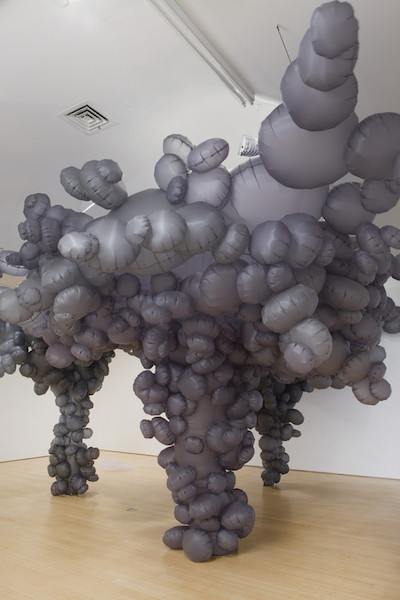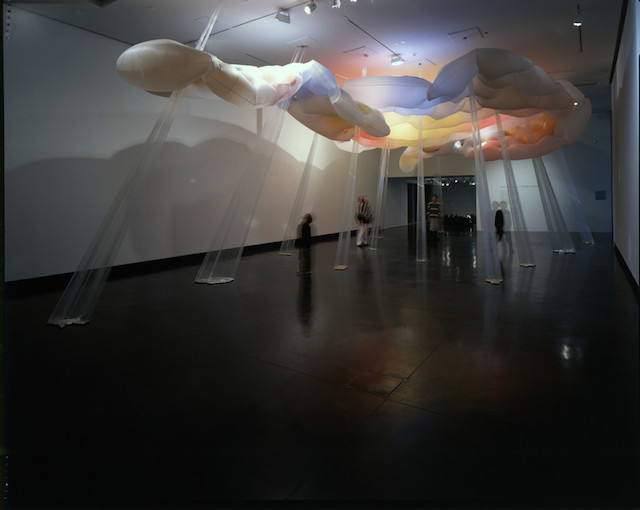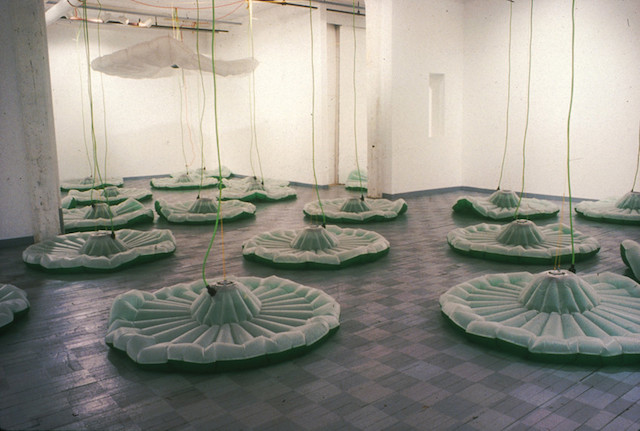(NORTH ADAMS, Mass.) – Plastic Fantastic, an exhibition of works by New York-based artist Lee Boroson featuring immersive installations that use inflatables, fabric, and light to create phenomenological experiences based on elemental forces in nature, opens in MASS MoCA‘s largest gallery in Building 5 on October 11, 2014. An opening reception will be held that day from 4 to 6pm.
Boroson’s title alludes to utopian ideas held by past generations about the shiny and new as symbols of the future. In his largest-ever exhibition, Boroson makes full use of the museum’s renovated buildings to construct four discreet, yet related components that create a new landscape within the architecture of a massive gallery space.
Beginning with ideas of nature, Boroson mediates between the landscape as culture – as opposed to notions of the outdoors as “wild” or “untamed.” He achieves this through the notion of material surrogacy – which considers how one material can become a stand-in for a natural event, and how that transformation can then be used to redefine the landscape. Boroson emulates phenomenological experiences for his viewers, based on the most ineffable elemental forces in nature – from air, fog, and smoke, to fire and the cosmos.
Four elements in the installation are: The Fog, The Falls, The Crypt, and The Lava Field. After moving through each sequentially, viewers will reach the upper mezzanine, a vantage point from which they can see the first two sections of the landscape resolve as a single image.
Transformation of materials is at the heart of Plastic Fantastic, beginning with The Fog, an installation that wipes away structural landmarks to leave behind a sense of negative space. Multi-layered and intricate, The Fog consists of sheer fabric draperies, transparent and translucent forms made of sheet plastic, and fabric canopies sewn and arranged to create passageways. Comparable to moving through shifting fog, the installation creates the effect of a haze to give viewers some moments of clarity and to obscure their vision through layers of vinyl, consistently altering their perception and sense of scale.
After navigating The Fog, viewers enter The Falls, a subtle, referential ode to the tourist’s experience of visiting Niagara Falls. The work plays on Boroson’s fascination with the highly engineered and controlled nature of the site. Complete with an overwhelming white noise much like that of Niagara Falls itself, Boroson’s floor-to-ceiling sculpture contains a constantly spouting stream of reflective and translucent objects (polypropylene spheres normally used to prevent the evaporation of reservoirs and other large bodies of water). As in a fountain, the material will be cycled back to the top and re-dropped. The conveyed elements, shiny and silver, will reflect everything around them while in motion, giving a magical effect of falling water and the intense auditory experience of being near Niagara.
Two mezzanine galleries represent the earth and fire components of the exhibition, both referencing variations on geological structures. The Crypt comprises an array of inflatable fabric forms to evoke the architecture of the underworld, providing room for contemplation in a dark, primordial chamber. Initially inspired by columns of smoke pouring out of burning oil wells and imagery of volcanic eruptions, Boroson sees a direct correlation with the gothic architectural elements of crypt spaces and the elaborate foundations of cathedrals. This subterranean architecture reflects the landscapes of caves, the earth’s own architecture, evolved at a glacial pace.
Directly above, on the second level of the mezzanine, The Lava Field is a “field” of hand-blown glass shapes containing lava-like fluids that recall the iconic imagery of lava lamps. Each of the over 80 vessels will contain an oozing, burbling liquid display in variations of white, similar to that of the inside of a lava lamp. The objects here will be presented as mounts in a trophy room, with some on wall shelves and others on floor displays. In referencing the hunting trophy, Boroson comments on the human desire to manage its environment; he simultaneously contains miniature representations of one of nature’s most powerful forces: lava. Visitors are invited to explore this alternate landscape in the soft glow of the lava and explore the wide range of specimens presented.
In Plastic Fantastic, Boroson’s landscape representations exist in the comparatively controlled and stable environment of the architectural interior, a space in which viewers are able to step outside, suspend disbelief, and enter a scene where the abstract becomes real.
Lee Boroson lives and works in Brooklyn, N.Y. Recent exhibitions include Lunar Bower at the Phillips Collection, Washington, DC, and States of Matter at the Esther Massry Gallery, The College of Saint Rose, Albany, NY. He has had solo exhibitions at various venues, including The Frances Young Tang Teaching Museum and Art Gallery, Skidmore College, Saratoga Springs, NY; Artspace, New Haven, CT; Hallwalls Contemporary Arts Center, Buffalo, NY; Bemis Center for Contemporary Arts, Omaha, NE, and the Whitney Museum of American Art at Philip Morris, NY. Boroson has received numerous awards, including grants from the Pollock-Krasner Foundation and the New York Foundation for the Arts, and professional development grants from the Rhode Island School of Design. He received an MFA from Indiana University and a BFA from the State University of New York, New Paltz, and attended the Skowhegan School of Painting and Sculpture. Boroson currently teaches at the Rhode Island School of Design, Providence, R.I.
Opening Reception
Saturday, October 11, 5-6:30pm
Free to members / $7 for not-yet-members
Reservations for the opening reception can be made by phoning 413.664.4481 x8157 or rwehry@massmoca.org.



